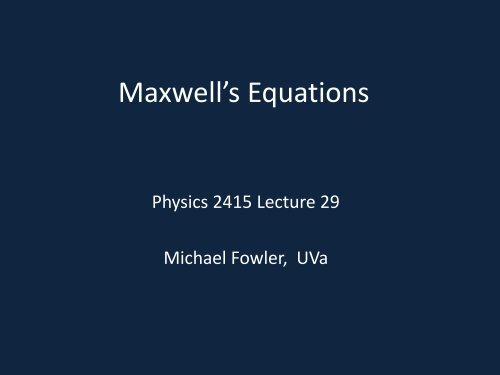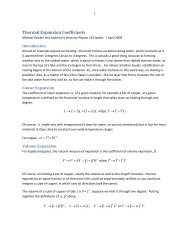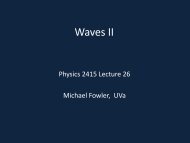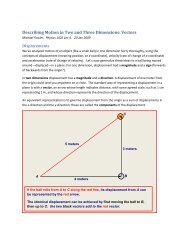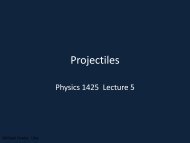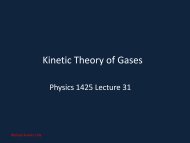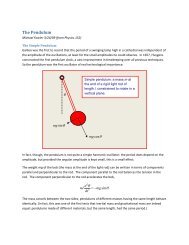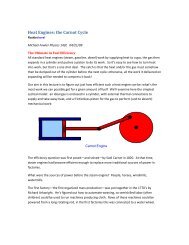Physics 1425: General Physics I - Galileo and Einstein
Physics 1425: General Physics I - Galileo and Einstein
Physics 1425: General Physics I - Galileo and Einstein
You also want an ePaper? Increase the reach of your titles
YUMPU automatically turns print PDFs into web optimized ePapers that Google loves.
Maxwell’s Equations<br />
<strong>Physics</strong> 2415 Lecture 29<br />
Michael Fowler, UVa
Today’s Topics<br />
• Maxwell’s equations<br />
• The speed of light
Equations for Electricity <strong>and</strong> Magnetism<br />
• Gauss’ law for electric fields<br />
<br />
E dA<br />
<br />
q / <br />
0<br />
the electric flux out of a volume = (charge inside)/ 0 .<br />
• Gauss’ law for magnetic fields<br />
<br />
BdA<br />
<br />
0<br />
• There is no such thing as magnetic charge: magnetic<br />
field lines just circulate, so for any volume they flow<br />
out of, they flow back into it somewhere else.
Equations for Electricity <strong>and</strong> Magnetism<br />
• Electrostatics: (no changing fields)<br />
Ed<br />
around any closed curve: this means the work done against<br />
the electric field from A to B is independent of path, the<br />
field is conservative: a potential energy can be defined.<br />
• Faraday’s law of induction: in the presence of a changing<br />
magnetic field, the above equation becomes:<br />
<br />
<br />
<br />
E d d / dt B dA d<br />
/ dt<br />
<br />
the integral is over an area “roofing” the path. A changing<br />
magnetic flux through the loop induces an emf.<br />
<br />
0<br />
<br />
B
Equations for Electricity <strong>and</strong> Magnetism<br />
• Mangnetostatics:<br />
<br />
Bd<br />
I<br />
0<br />
around any closed curve: I is the total current flow across<br />
any surface roofing the closed curve of integration.<br />
• But is this the whole story?<br />
• Fields changing in time changed the electrostatic equation,<br />
what about this magnetostatic equation?<br />
• Let’s look at a particular case…
Spherical Current<br />
• At t = 0, a perfectly spherical ball of charge is<br />
placed at the center of a very large spherical<br />
conductor. The charge flows away equally in<br />
all directions. What is the magnetic field<br />
generated?<br />
• 1) It points outwards equally in all directions<br />
• 2) Same but pointing inwards<br />
• 3) It circles around the initial sphere<br />
• 4) No magnetic field is produced by these<br />
currents
Those Spherical Currents…<br />
• Cannot produce a magnetic field!<br />
• The configuration has perfect spherical<br />
symmetry—it would not be changed by<br />
turning it through an angle about any axis.<br />
• The only fields satisfying this would point in or<br />
out along radii everywhere—but that could<br />
only happen with a net magnetic charge (N or<br />
S) at the center. So, no field at all…
Ampère’s Law <strong>and</strong> Spherical Currents<br />
• Imagine in 3D currents flowing spherically<br />
outward symmetrically from a ball of<br />
charge injected into a large conducting<br />
medium.<br />
• Imagine a circular curve, like a crown,<br />
placed above the source. Clearly some of<br />
the current flows through a surface roofing<br />
this loop, so 0 I is nonzero.<br />
• But Bd 0<br />
around the loop, because the<br />
field B is zero everywhere!<br />
• So Ampère’s law is not the whole story…
Another Ampère’s Law Paradox<br />
• Suppose now a capacitor is<br />
being charged by a steady<br />
current in a wire.<br />
• Consider Ampère’s law for a<br />
circular contour around<br />
the wire—it’s supposed to<br />
be the same for any surface<br />
S roofing the circle, but we<br />
could choose S 2 , going<br />
between the plates, so no<br />
current crosses it!<br />
I
Maxwell’s Solution<br />
• Maxwell knew Faraday had generalized the<br />
electrostatic law to include a time-varying magnetic<br />
field by adding the changing flux through the curve:<br />
• He noticed that when Ampère’s law failed, there was<br />
a time-varying electric field through the surface<br />
roofing the curve, <strong>and</strong> suggested including it like this:<br />
<br />
• (Writing<br />
<br />
<br />
E d d / dt B dA d<br />
/ dt<br />
<br />
d<br />
<br />
<br />
B d 0 I 0<br />
E dA 0I 0<br />
0<br />
d<br />
E<br />
/ dt<br />
dt <br />
<br />
E dA<br />
<br />
E<br />
, the electric flux.)<br />
<br />
B
Why the Two Surfaces Give the Same Result<br />
• The current I flowing<br />
through surface S 1 is the rate<br />
of change of charge on the<br />
top capacitor plate, I = dQ/dt.<br />
• If the plates are close, all the<br />
electric field from the top<br />
plate will point down, none<br />
will cross S 1 , so E dA<br />
/<br />
<strong>and</strong><br />
d<br />
d<br />
dQ<br />
<br />
dt dt dt<br />
<br />
E<br />
0<br />
E dA<br />
0<br />
<br />
S<br />
2<br />
S<br />
<br />
S<br />
1 2<br />
Q <br />
I<br />
0<br />
Bottom line: the rate of change of electric<br />
flux through S 2 = current through S 1 .<br />
I
Ampère’s Law <strong>and</strong> Charge Conservation<br />
• Ampère’s law cannot work by<br />
itself for all surfaces spanning<br />
a circle like this:<br />
• The surface S 2 is drawn to<br />
avoid the current. This is only<br />
possible because charge is<br />
piling up. The rate of change<br />
of electric flux just equals 1/ 0<br />
times how fast the charge is<br />
piling up, from Gauss’ law.<br />
• This must equal the ingoing<br />
current— so the integral over S 1 = that over S 2 .<br />
I
Maxwell’s Equations<br />
• The four equations that together give a<br />
complete description of electric <strong>and</strong> magnetic<br />
fields are known as Maxwell’s equations:<br />
E dA<br />
q / 0<br />
BdA<br />
0<br />
<br />
<br />
<br />
E d d<br />
/ dt<br />
B<br />
B d<br />
I <br />
0 0 0<br />
d<br />
dt<br />
E<br />
Maxwell himself<br />
called this term the<br />
“displacement<br />
current”: it<br />
produces magnetic<br />
field like a current.<br />
online notes
Magnetic Field In Charging Capacitor<br />
• Taking the field between plates<br />
uniform, use<br />
<br />
Bd<br />
I<br />
<br />
0 0 0<br />
d<br />
dt<br />
EdA<br />
• For a disc surface between the<br />
plates, there is no current I through<br />
the surface, there is a changing<br />
electric field uniform over the area,<br />
generating a circular magnetic field.<br />
<br />
• .<br />
I<br />
• For the total plate area,<br />
<br />
d<br />
<br />
dt dt dt<br />
d E<br />
0<br />
E dA<br />
dQ <br />
I<br />
0
Magnetic Field In Charging Capacitor<br />
• For the total area<br />
d dQ<br />
0<br />
E dA I<br />
dt<br />
dt<br />
• .<br />
• For a disc of radius r, the total<br />
changing electric field is given by<br />
<br />
d<br />
dt<br />
<br />
E dA<br />
<br />
r<br />
R<br />
0 2<br />
I<br />
2<br />
R<br />
r<br />
I<br />
• Now use<br />
to find<br />
B<br />
<br />
<br />
B d<br />
0I r<br />
2<br />
R<br />
<br />
2<br />
d<br />
dt<br />
<br />
0 0<br />
E<br />
dA<br />
between plates.
Charging Capacitor <strong>and</strong> Betatron<br />
• Recall that in the betatron a uniform magnetic<br />
field increasing in strength in time generated a<br />
circling electric field that could be used to<br />
accelerate charged particles.<br />
• In the charging capacitor we’ve been looking<br />
at, a uniform electric field increasing in<br />
strength in time generates a circling magnetic<br />
field.<br />
• In regions of space where there are no charges,<br />
changing electric <strong>and</strong> magnetic fields are<br />
related to each other in a very symmetric way.
Clicker Question (Review)<br />
• Suppose you have an infinite uniform plane of<br />
electric charge. What is its electric field?<br />
A. Parallel to the plane, of uniform strength.<br />
B. Parallel to the plane, decreasing strength<br />
with distance from the plane.<br />
C. Perpendicular to the plane, of uniform<br />
strength throughout space.<br />
D. Perpendicular to the plane, decreasing<br />
strength with distance from the plane.
Clicker Answer<br />
• C: Perpendicular to the plane, of uniform<br />
strength throughout space.<br />
• An infinite plane is of course an idealization: but<br />
for a uniform plane charge distribution of finite<br />
size, the electric field has very close to uniform<br />
strength for distances from the plane less than<br />
the linear size of the charge distribution.
Clicker Question<br />
• Suppose now the uniformly charged plane is<br />
set in motion with constant velocity. This<br />
means we have a plane of electric current.<br />
• The magnetic field generated by this current:<br />
A. Is perpendicular to the plane.<br />
B. Is parallel to the plane, <strong>and</strong> in the same<br />
direction as its velocity.<br />
C. Is parallel to the plane, <strong>and</strong> perpendicular to<br />
the velocity direction.
Clicker Answer<br />
• Is parallel to the plane, <strong>and</strong> perpendicular to<br />
the velocity direction.<br />
• Remember the Biot Savart law:<br />
dB<br />
0I d<br />
4<br />
• The magnetic field from a small piece of<br />
current is perpendicular to the current<br />
direction—but in this moving plane, all<br />
current flow is in the same direction, so all<br />
fields are perpendicular to that direction.<br />
<br />
rˆ<br />
2<br />
r
Magnetostatic Field from a Sheet of Current<br />
(no net charge: current in metal sheet)<br />
• A large uniform sheet of<br />
electric current: think of it<br />
as many parallel close wires<br />
perpendicular to the screen,<br />
current flowing downwards,<br />
I amps per meter.<br />
• .<br />
L<br />
B-field<br />
Infinite uniform<br />
current sheet:<br />
flows into screen<br />
• What is the magnetic field?<br />
There can be no perp field.<br />
• It’s OK to use Ampère’s law<br />
with rectangular contour,<br />
the enclosed current is IL.<br />
<br />
Bd<br />
<br />
IL<br />
gives B = 0 I/2.
Switching on the Current Sheet<br />
• If the current sheet is<br />
suddenly switched on, in<br />
the first moments the<br />
magnetic field is only<br />
established close to the<br />
sheet.<br />
• We’ll assume it moves<br />
out like a tidal wave away<br />
from the sheet, at speed<br />
v, so at time t it extends<br />
out to vt, with nothing<br />
beyond.<br />
• .<br />
(No B-field out here yet.)<br />
vt<br />
vt<br />
(No B-field out here yet.)<br />
B-field<br />
Infinite uniform<br />
current sheet:<br />
flows into screen
Ampère’s Law at Time t<br />
• This rectangular contour still<br />
includes current LI, but<br />
clearly Bd 0.<br />
• What’s going on?<br />
• We know the correct<br />
equation is really<br />
<br />
<br />
Bd LI d<br />
dt<br />
0<br />
00 E<br />
/<br />
• This will be correct only if<br />
there is also an electric field<br />
perpendicular to the loop, its<br />
flux increasing with time.<br />
• .<br />
(No B-field out here yet.)<br />
vt<br />
vt<br />
(No B-field out here yet.)<br />
B-field
Ampère’s Law at Time t<br />
• As soon as the exp<strong>and</strong>ing<br />
magnetic field reaches our<br />
loop, Bd<br />
0LI<br />
<strong>and</strong> there<br />
can be no further change in<br />
the perpendicular electric<br />
field.<br />
• This means the electric field E<br />
is spreading right along with<br />
the magnetic field, at v, so<br />
• .<br />
(No B-field out here yet.)<br />
dE<br />
/ dt 2EvL<br />
<strong>and</strong> from<br />
0 00<br />
we find for field strengths B <br />
I /2<br />
vE<br />
vt<br />
vt<br />
(No B-field out here yet.)<br />
B-field<br />
0 Bd LI dE<br />
/ dt<br />
0 0 0
Picturing the Fields…<br />
• The current sheet is in the<br />
xy-plane, current in the –x<br />
direction.<br />
• At time t after switch on,<br />
the fields will have reached<br />
vt as shown (we show one<br />
way—fields go –z too).<br />
• We haven’t yet used<br />
• . x<br />
Electric field<br />
vt<br />
y<br />
z<br />
Magnetic field<br />
<br />
E d d / dt BdA<br />
<br />
<br />
<br />
• What does that tell us?
Picturing the Fields…<br />
• So let’s look a<br />
• .<br />
<br />
E d d / dt BdA<br />
• Take a rectangular contour,<br />
two sides parallel to the<br />
electric field, one side<br />
beyond v: the integral gives<br />
. EL = vLB.<br />
• (we’re not worrying about<br />
sign—these are field<br />
amplitudes.)<br />
<br />
<br />
<br />
x<br />
Electric field<br />
vt<br />
y<br />
z<br />
L<br />
Magnetic field
The Speed of Light<br />
• To summarize: for the outward traveling<br />
magnetic <strong>and</strong> electric fields from a switched-on<br />
current sheet, the equation<br />
<br />
gives B <br />
I /2 vE .<br />
• The equation<br />
Bd LI d<br />
dt<br />
0 0 0<br />
<br />
0<br />
00 E<br />
/<br />
E d d / dt BdA<br />
gives E = vB.<br />
• They both give the ratio B/E— <strong>and</strong> that fixes v!<br />
B<br />
E<br />
1 1<br />
<br />
0 0v , so v 310<br />
m.sec<br />
v <br />
0 0<br />
<br />
<br />
<br />
8 1
The Speed of Light<br />
• This outgoing wave could have been made<br />
harmonic simply by oscillating the current in the<br />
sheet.<br />
• The wave’s outgoing speed is fully determined by<br />
0 , which—remember—we defined as 4x10 -7 , <strong>and</strong><br />
by 0 , which is measured in electrostatic<br />
experiments.<br />
• But the speed is exactly that of light!<br />
• Maxwell concluded that light is an electromagnetic<br />
wave.
The Electromagnetic Spectrum<br />
• The equations place no restriction on possible<br />
wavelengths of these electromagnetic waves.<br />
It follows that light, with wavelengths only<br />
between 400 nm <strong>and</strong> 750 nm, is a small part<br />
of a vast electromagnetic spectrum—see the<br />
next slide…


